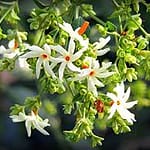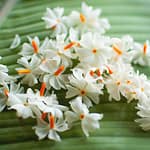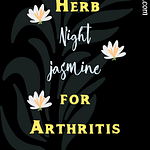
Harsingar’s origins in mythology are as interesting as its diverse medicinal values. As far as history goes, it is said that this ‘heavenly’ plant was brought to Earth by Lord Krishna after extensively searching for it in the ocean (Samudra). Owing to its intense fragrance and beautiful physical characteristics, Krishna’s wives – Rukmini and Satyabhama – ended up fighting for it. To resolve the quarrel, Lord Krishna planted the Parijaat tree in Satyabhama’s courtyard in such a manner that upon flowering, Harsingar’s blooms would fall in Rukmini’s courtyard – a win-win for all!
In this blog today, we will discover the powerful and therapeutic benefits of the Harsingar plant which helps to combat everyday health issues that people face on a daily basis. Often referred to as the ‘star’ plant, this miraculous plant species helps in treating worms and chronic fever. Most people know this fragrant plant by the names of Night Jasmine (English name), Parijat (Hindi name), Shefalika (Sanskrit name), or Nyctanthes Arbortristis (Botanical name).
Parijat primarily grows in tropical and sub-tropical areas such as South East Asia and is abundantly found in West Bengal (India). Note that this plant is considered ‘sacred’ according to Hindu mythology. In fact, its flowers are touted to be ‘pure’ and hence, are often offered to Lord Shiva. This plant is often planted near temple sites across India, Malaysia, Indonesia, and Sri Lanka.
“As long as we are not living in harmony with nature and our constitution, we cannot expect ourselves to be really healed. Ayurveda gives us the means.” ― David Frawley
Harsingar’s Uses: The Anatomy of the Harsingar Plant
Belonging to the Oleacea family of plants, the Harsingar plant’s benefits outweigh any other in the Ayurvedic world. You’ll be surprised to know that just one Harsingar tree can add tons of positive vibe and an intense fragrant environment to your neighbourhood. Generally, the plant’s leaves, flowers, fruits, bark, and seeds are used in diverse forms such as the following:
Recommended Dose:
- Decoction (kwatha): 50-100 ml
- Juice extract: 10-20 ml
- Powder/churna: 1-3 gm
Moving on, let’s look at the anatomy of the multi-purpose plant:
- Harsingar plant: The Parijatham plant or Parijat plant grows as a small tree/shrub and typically blooms at night. That said, it cannot survive without sunlight and grow in extremely cold weather conditions.
- Harsingar flower: Containing the dual benefits of essential oils and glycosides, the attractive Parijat flower offers anti-fungal, anti-leishmanial, hepatoprotective, immuno-stimulant, carminative, ophthalmic, and anti-viral properties. In fact, in India, Malaysia, etc., the flowers are used extensively to stimulate better menstrual flow. You can use the essential oil that’s extracted from the flowers of this plant and massage your body to keep it fit and strong. Plus, Harsingar oil is known to fight fungal infections and treat skin problems like blackheads, pimples, etc.
- Harsingar leaves: The Parijat tree leaves benefits have been mentioned in a host of Ayurvedic works such as “Priya Nighantu,” “Nighantu Aadarsha,” “Hridaya-Deepika Nighantu,” etc. Not surprisingly, numerous bees are known to reside on the fragrant tree and it is used for making dyes and perfumes. The leaves are bitter and pungent in taste and help to treat fever, fungal infections, etc. Plus, the leaves are widely used in a variety of homoeopathic medicines. Extracts from its leaf’s juice help in treating sciatica, rheumatism, snake bites, etc.
- Harsingar’s bark: Used as an expectorant and a tanning material, the bark treats ulcers, eye problems, and bleeding gums.
Did You Know?
The plant double’s up as an effective dye imparting a gorgeous orange colour and thus, works as a cheaper version of saffron for dyeing robes for Buddhist priests.
How to Make a Herbal Tea using Parijatha Flowers?
People in Taiwan and China consume this tasty and super-healthy herbal tea on a regular basis. It is easy to make and delicious to consume. Here are the steps for your reference:
Step 1: Take 1-2 Harsingar flowers, 1-2 Tulsi leaves, and 1-2 Harsingar leaves, and let it boil in a glass of water for some time.
Step 2: You’ll notice that the colour changes and your tea is ready!
Note: You don’t need to add any milk/sugar/sweeteners, making it a herbal tea that boosts your health and contributes to overall well-being! Also, remember that just 1-2 flowers are enough.
Harsingar’s Health Benefits: At A Glance

This all-powerful plant helps to treat numerous diseases and health concerns that arise due to aggravated Vata and Kapha. These include:
- Dandruff/lice
- Scurvy
- Cough and respiratory issues
- Vertigo
- High blood pressure
- Malaria
- Constipation
- Menstrual cramps
- Piles
- Anxiety
- Arthritis,
- Gastritis
In terms of the medicinal properties, it offers laxative, anti-viral, analgesic, anti-inflammatory, anti-bacterial, and anti-fungal benefits, making it super useful in the case of infections. The Harsingar leaves powder extract comes with healing properties and can help treat:
Knee Pain
Harsingar leaves for knee pain is a God-send.
The Suggested Remedy: Make a decoction of 4-5 Harsingar leaves and a glass of water. Let it boil till it gets reduced to half the quantity and strain it. Consume it daily on an empty stomach for 3 months (not more).
Arthritis
Harsingar for arthritis is one of the best natural remedies available to us. When consumed orally, night jasmine extracts have the power to heal inflammation in joints.
The Suggested Remedy: Acharya Balkrishna suggests you take 5 gm of dried or raw Harsingar’s leaves, flowers, and bark and let it boil in 200 gm water. Consume this kadha once a day and say goodbye to the mind-numbing arthritic pain!
Sciatica
If you’re suffering from sciatica and constantly face issues in moving around, take 3-4 Harsingar leaves and grind it. Add it to two glasses of water and let it boil for some time. Strain this mixture and drink twice a day for best results.
Dengue/Chikungunya
One of the foremost concerns for any person suffering from dengue is getting the blood platelet count up and rising. This is where Harsingar can prove to be useful. It can either be taken as a decoction or in the raw form.
Suggested Remedy: Take 4-5 Harsingar leaves, grind black pepper/kali mirch, and boil this in 3 glasses of water. Keep boiling till it gets reduced to half of the quantity and take 1 sip every half-an-hour for 12 hours.
Bodily Pain And Swelling
For general weakness and body pain, drinking the Harsingar kadha (decoction) extracted from its leave can help.
Cough, Mucous, And Cold
Constant cough can leave you feeling weak and irritated. To counteract this, Acharya Balkrishna suggests you make herbal tea from the Harsingar leaves. To make 5-7 cups of tea, take 2-3 leaves and grind with your hands. Then add water and add 2-3 flowers to this mixture and let it boil. Then strain and drink. You can also add tulsi for added benefits. Conversely, to remove phlegm, take small pieces of the Night Jasmine stem bark and Areca nut. Wrap these two in Harsingar leaf and chew. Make sure to wash everything before chewing.
Roundworms And Threadworms In Children’s Stomach
For children who often get worms in their stomach, take 2 leaves of the Harsingar plant and grind it with little water to extract its juice. Then, add a little mishri/honey to 1 teaspoon of the juice extract and let your child consume it on an empty stomach early in the morning.
Recurring High Fever / Chronic Malaria
If you’re experiencing fever on and off, diarrhoea, and nausea, you can take 3 gm Harsingar’s bark, 2 gm of its leaves, and 2-3 Tulsi plant’s leaves and boil it in a glass of water. Strain this mixture and drink it twice a day. In a couple of days, you’ll notice that the fever has reduced to a great extent.
Eye Pain And Eye Diseases
You can prepare Harsingar taila (oil) by mixing kanji (rice gruel) and rock salt along with the bark of the tree and apply. Please consult your doctor to understand the process and recommended dose for each ingredient.
Anaemia
For treating anaemia, Parijata leaves, ginger juice, honey, and loha bhasma are used. Your ayurvedic practitioner will be able to guide you regarding the process.
Hair Loss
If you’re experiencing extreme hair loss, prepare a paste using its seeds and water and apply on the affected areas.
Important: Please seek expert help to understand the recommended dosage on the basis of your health history, relevant symptoms, unknown allergies, etc.
Side Effects & Precautionary Measures
- Harsingar is quite bitter in taste, so people with a sensitive taste bud may experience nausea.
- Due to its intrinsic yellow colour, your tongue may become yellow if you chew the leaves raw.
Did you find this post useful? Would you like to get back to it later? Save THIS PIN below to your Pinterest Natural Living or Ayurveda board!


No comment
It’s a very useful plant, and text is very informative, a good source as antiviral too